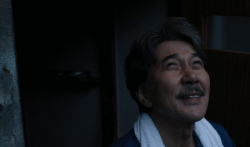“Too much of anything is never good,” artist Sangram Majumdar shared with the crowd gathered at Georgetown’s Spagnuolo Gallery on Sept. 10. I quickly understood his point while staring at the dozen pieces selected for his new show, “Just Like.” Walking through the gallery, I felt that only if I squinted my eyes and leaned in a little closer to the paintings, pressing my nose up against the complex canvases, would I find important details to help me understand exactly what Majumdar had chosen as his subjects—and why. From a distance, the paintings seemed decipherable, but upon closer inspection, I lost grasp of my understanding. The artist’s work struck me as simultaneously familiar, yet out-of-reach.
Majumdar draws his inspiration from interruption, fragmentation, and collision. His artist’s statement reveals that his paintings, “inhabit the territory between ‘I know you’ and ‘What’s that?’” As evidenced by this exhibition, Majumdar does not provide answers with his paintings, but rather seeks to inspire exploration. He hopes the viewer’s experience ends not with one objective opinion, but with more questions than when they started. (https://romantichoneymoonisland.com) By juxtaposing identifiable objects with experimental and imaginary forms, Majumdar does just that.
Two paintings in particular stood out from the rest: “Torque” and “Missing Trees.” “Torque”, with its strong, geometric repetitions and rich earth tones drew viewers closer for a second glance. Standing in front of the work, I felt as if I was peering through a stack of canvases leaning against a wall of the artist’s studio. Another viewer could have just as easily stood in front of the piece and had an entirely unique impression. For that reason, interaction with Majumdar’s artwork, despite its claim to abstractionism, is a deeply personal experience.
The pair of oil paintings that make up Missing Trees, made to look like white cardboard cutouts of trees against wooden boards, challenges the viewer to consider not only what appears on the canvases, but also what doesn’t. Without a title, I would have had difficulty contextualizing the objects. Ironically, the title refers to the objects that are absent from the painting. As a result, I was forced to confront the negative space and the unexpected composition it created. Majumdar mentioned that as he worked on the paintings, “[he] realized that something about the space between the two paintings began to echo the space between the cracks of wood.” The spontaneity was clear.
These two pieces are the highlights of the exhibit, successfully playing with the abstract space and forms on the canvas, and creating a subjective experience for the viewer. Several others of Majumdar’s works fail to impress. In some cases, the paintings feel incomplete or compositionally weak. Other works were too abstract, and didn’t give enough context to stimulate conversation, rendering the paintings unfamiliar and unapproachable.
In his Spagnuolo Gallery exhibition, Majumdar’s artwork doesn’t claim to be “Just Like” anything. In fact, on the contrary, the artists leaves it to the viewer to interact with each piece uniquely, and form their own opinion and relationship with the piece. His work embodies his ethos that too much of something is detrimental, but often, Majumdar’s paintings leave the viewer craving for just a little bit more.
Spagnuolo Art Gallery
Sept. 10 – Oct. 12
1221 36th St., N.W.
art.georgetown.edu





